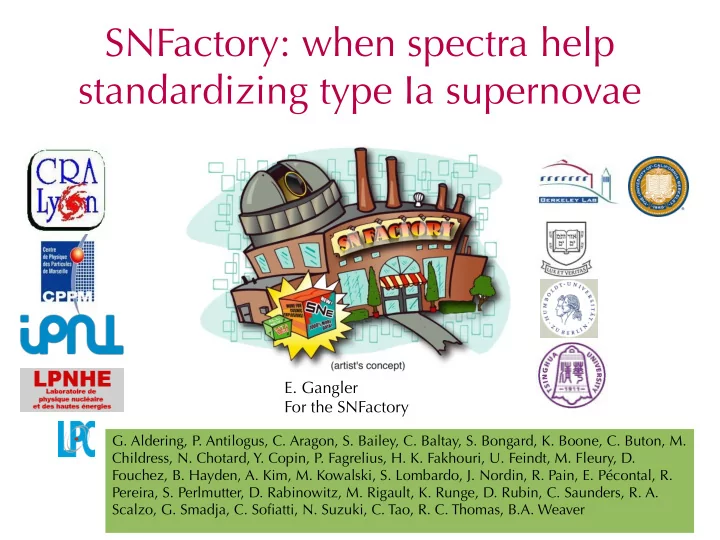

SNFactory: when spectra help standardizing type Ia supernovae SNFactory E. Gangler For the SNFactory G. Aldering, P. Antilogus, C. Aragon, S. Bailey, C. Baltay, S. Bongard, K. Boone, C. Buton, M. Childress, N. Chotard, Y. Copin, P. Fagrelius, H. K. Fakhouri, U. Feindt, M. Fleury, D. Fouchez, B. Hayden, A. Kim, M. Kowalski, S. Lombardo, J. Nordin, R. Pain, E. Pécontal, R. Pereira, S. Perlmutter, D. Rabinowitz, M. Rigault, K. Runge, D. Rubin, C. Saunders, R. A. Scalzo, G. Smadja, C. Sofjatti, N. Suzuki, C. Tao, R. C. Thomas, B.A. Weaver
Spectrophotometric time series Hubble flow SN1a 0.03<z<0.07 Blind Untargeted search 2
Principle of SNIFS instrument: data Sky+galaxy Photometric channel IFU : 15x15=225 spectra SN + sky + galaxy Sky MLA : 2 channels 0.32 – 0.54 µm @ 2.4 Å 0.54 – 1.0 µm @ 2.9 Å 6''x6'' FOV @ 0.4''/spax 9.4'x9.4' FOV @ 0.14''/pix Reconstructed SN Observations every 2-3 days : Observations every 2-3 days : Spectrophotometric time series Spectrophotometric time series 3 On sky since 2004
The sample so far Palomar/QUEST search over in 2008 → untargeted search SNF2 started 2011 with PTF SNIa and LSQ Still running ... Total Spectred supernovae 1123 Good SNIa 232 (with fmux calibration) supernovae Good spectra 3462 Spectra / SN ~15 SNF20080720-001
The sample so far Palomar/QUEST search over in 2008 → untargeted search SNF2 started 2011 with PTF SNIa and others Still running ... Total Calibrated supernovae 614 >=4 epochs 287 Gold SNIa supernovae 234 Gold spectra 3503 Spectra / SN ~15 Some spectra around ... maximum light
Example : SN2011fe SN2011fe time serie Synthetic photometry Bolometric light-curve Pereira 2013
Some astrophysics results Derivation of ejected mass Comparison with explosion models Total mass 56 Ni mass Delayed detonation Merger model x1 S u p e r - C h a n d r a Röpke 2012 C S … see also Sasdelli 2015 u h b a - n d r a Scalzo 2014
Calibration accuracy Given by repeated observations on Standard Stars Validation on Supernova ~ 4700 observations of 28 Stdstars Departure from SALT2 model Achromatic scatter ~ 0.03 Zero-points and scatter under control Color RMS 0.005 - 0.011 mag → calibration uncertainies correlated
SALT2 standardization from spectral series SN2005el Integration on top-hat custom fjlters : Minimal loss of fmux No band overlap B,V,R SNf to fjt x1,c Standard Hubble diagram fjt : Reduces residuals from 0.40 to 0.15 mag Added magnitude dispersion Low value for beta
Beyond traditional SALT2 ● Host studies ● SED model ● Twins
Global Host Analysis Childress 2013 Mass-metallicity of SNF hosts Mass Step ● SN hosts follow normal mass-metallicity relation ● Color-metallicity follows Hoefmich prediction ● Simple A+B model for host mass distribution ● Mass step comes from age and statistical properties, not metallicity
→ leads to similar analyzes in JLA sample
Bias due to local environment Bias on w Bias on H0 Could affect w by a few % → HST host observation campaign going on
Building an SED model beyond SALT2 SED The SUGAR approach : 3 intrinsic parameters → Physically inspired (derived from spectral indicators) 1 color → no a priori on color shape There is also the GP-based approach (Kim, Saunders) SN2011fe (Pereira et al. 2013)
SUGAR Spectral Energy Density model : Model response : Average spectrum Stretch Spectral vector 1 : (0.13 mag) Shallow → Brighter / Shallower = stretch Deep
SUGAR Spectral Energy Density model : Model response : Average spectrum Spectral vector 1 : (0.13 mag) → Brighter / Shallower = stretch Spectral vector 2 : (0.04 mag) → Ca / Si correlation = marginal on LC
SUGAR Spectral Energy Density model : Model response : Average spectrum Spectral vector 1 : (0.13 mag) → Brighter / Shallower = stretch Spectral vector 2 : (0.04 mag) → Ca / Si correlation = not seen by SALT2 Impact on color law
SUGAR Spectral Energy Density model : Model response : Average spectrum Spectral vector 1 : (0.13 mag) → Brighter / Shallower = stretch Spectral vector 2 : (0.04 mag) → Ca / Si correlation Impact on color law Spectral vector 3 : (0.04 mag) → Still Ca / Si infmuence → Global impact on LC
Using SUGAR as a fjtter : Spectral time serie view Light-curve view Spectral and Light-curve Pre-validation sample Spectral and Light-curve description improved nMAD Bsnf Vsnf Rsnf description improved SALT2 0.073 0.051 0.056 Standardization 0.13 mag SUGAR 0.053 0.035 0.037 Standardization 0.13 mag Calib. 0.030 0.030 0.029
Another look at spectra : Twins Some SN look very similar (up to an extinction + offset) Do they have the same fmux ?
Another look at spectra : Twins Some SN look very similar (up to an extinction + offset) Do they have the same fmux ? ~50 SNIa Analysis v2.0 in progress Fakhouri 2015
Bulk fmow studies Feindt 2013
Conclusions ● SNIFS instrument still alive and running ! – 5-10 nights/semester for calibration, SN screening, – would need refurbishing for more ambitious survey ● Data quality is good enough for cosmological use – 0.15 mag SALT2 dispersion as other surveys – still some improvements going on : Stdstar network, non-linearity investigation, … ● Improvement of standardization techniques – SED model, multiband fjt → 0.12-0.13 total dispersion easily achieved – 0.08 mag standardization achieved on best twins SN… ● More analysis to come...
Recommend
More recommend